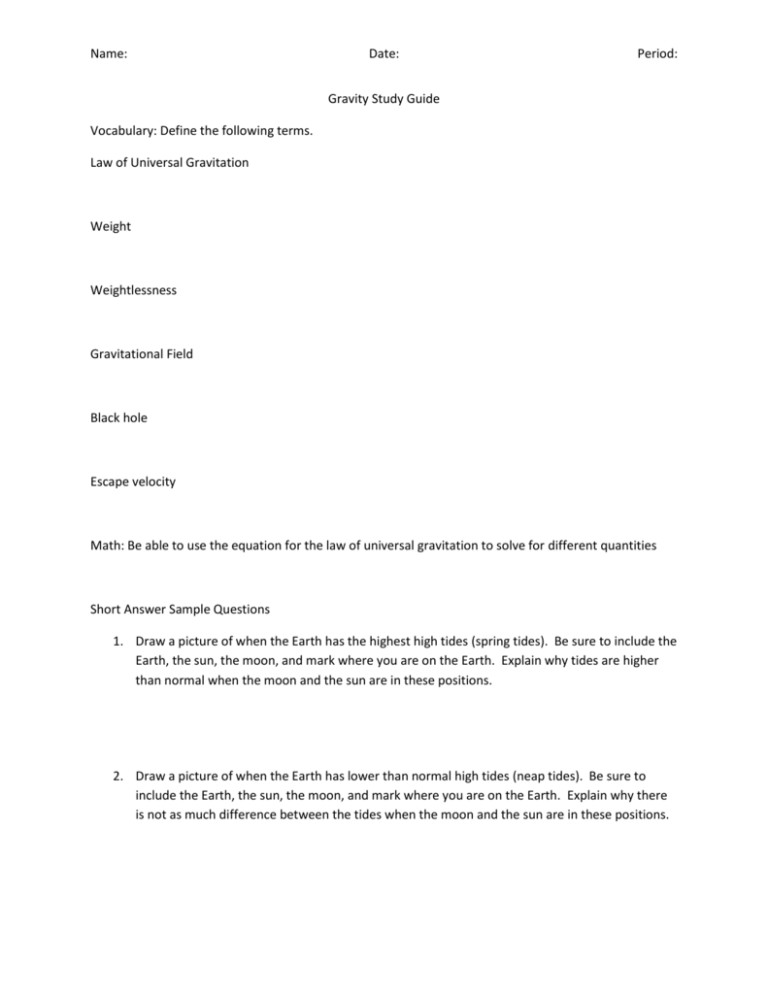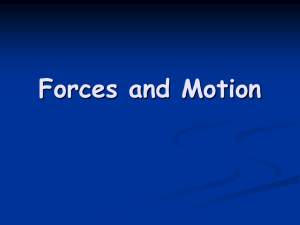Name: Date: Period: Gravity Study Guide Vocabulary: Define the
advertisement

Name: Date: Period: Gravity Study Guide Vocabulary: Define the following terms. Law of Universal Gravitation Weight Weightlessness Gravitational Field Black hole Escape velocity Math: Be able to use the equation for the law of universal gravitation to solve for different quantities Short Answer Sample Questions 1. Draw a picture of when the Earth has the highest high tides (spring tides). Be sure to include the Earth, the sun, the moon, and mark where you are on the Earth. Explain why tides are higher than normal when the moon and the sun are in these positions. 2. Draw a picture of when the Earth has lower than normal high tides (neap tides). Be sure to include the Earth, the sun, the moon, and mark where you are on the Earth. Explain why there is not as much difference between the tides when the moon and the sun are in these positions. Name: Date: Period: 3. Why does the moon stay in orbit? Why doesn’t it crash into the Earth or fly away? Explain with centripetal force and/or tangential velocity. 4. If you are standing on a bathroom scale in an elevator that starts moving upward, do the springs in the scale compress more or less? Is the reading of your weight greater or less? How does this explain astronauts and the feeling of “weightlessness”? 5. How does the force of gravity change when the mass of either object increases? How does it change when the distance between them increases? 6. If you go under the surface of a planet, is the force of gravity greater or less than on the surface? Why? 7. How did Henry Cavendish discover or measure the universal gravitational constant G? You may draw a picture to help explain. 8. Explain Einstein’s Theory of Gravitation. You may use an example from class. 9. Gravitational force acts on all bodies in proportion to their masses. Why then, doesn’t a heavy body fall faster than a light body? Name: Date: Period: 10. What would the path of the Moon be if somehow all the gravitational forces on it vanished to zero? 11. Is the force of gravity from the Earth stronger on a piece of iron than a piece of wood if both have the same mass? Defend your answer. 12. A friend says that, since Earth’s gravity is so much stronger than the Moon’s gravity, rocks on the Moon could be dropped and land on the Earth. What is wrong with this assumption? 13. The planet Jupiter is more than 300 times as massive as Earth, so it might seem that a body on the surface of Jupiter would weigh 300 times as massive as Earth, so it might seem that a body on the surface of Jupiter would weigh 300 times as much as on Earth. But it so happens that a body would scarcely weigh three times as much on the surface of Jupiter as it would on the surface of the Earth. Can you think of an explanation for why this is so? 14. Why does a person in free fall (astronaut) experience weightlessness, while a person falling at terminal velocity does not? 15. Why aren’t high tides exactly 12 hours apart? 16. If the Earth were of uniform density, would your weight increase or decrease at the bottom of a deep mine shaft? Defend your answer. Name: Date: Period: 17. It so happens that an actual increase in weight is found even in the deepest mine shafts. What does this tell us about how the Earth’s density changes with depth? 18. If our Sun shrank in size to become a black hole, explain how the Earth would be affected. 19. Some people dismiss the validity of scientific theories by saying they are “only” theories. The law of universal gravitation is a theory. Does this mean that scientists still doubt its validity? Explain. 20. Describe what we think happens to a person or spaceship that is sucked into a black hole. Explain why we think it happens. Math Practice: Write down the two equations we use to find force of gravity. 1. 2. How would you find the acceleration of gravity at a particular location? Name: Date: Period: Be sure to show all work, including equation, substitution, and answer with correct units. 1. An object weighs 100 N on the surface of the earth. Find its weight if it was 6.38 x 10 6 m above the surface? 2. Calculate the acceleration due to gravity at a point 1000 km above the surface of the earth. 3. The force of gravity on a 60 kg woman is 588 N. The woman also exerts a gravitational force on the Earth. How large a force is this? 4. The force of attraction between m1 and m2 is 26 N. What will this force become if m2 is tripled and the distance between it and m1 is halved? 5. The force of gravity between two masses was 14 N when they were 10 m apart. The distance between them was changed and the force became 56 N. How far apart were they then? 6. The force of gravity between A and B is 100 N. When the mass of B is doubled and the distance between it and A is quadrupled, what is the new force? Name: Date: Period: 7. If the moon’s mass were suddenly to double, what effect would this change have on the moon’s orbit, and how would such a change affect the Earth? (Assume that the velocity of the moon remains unchanged.) 8. What are the units of G in the MKS (m-kg-sec) system? 9. Calculate the gravitational attraction between a proton of mass 1.67 x 10-27 kg and an electron of mass 9.11 x 10-31 kg if they are 5 x 10-11 m apart (as they are in a normal hydrogen atom). 10. Find the acceleration of a falling object on Mars, given that the radius of Mars is one-half that of Earth and the mass of Mars is one-eighth that of Earth. 11. The planet Saturn has mass of 5.67 x 1026 kg and radius of 6.3 x 107 m. Find the acceleration due to gravity on Saturn. How much will the gravitational force be on a 60 kg man there? 12. A woman standing on the surface of the Earth, 6.38 x 106 m from its center, has a mass of 50.0 kg. If the mass of the Earth is 5.98 x 1024 kg, what is the force of gravity on the woman? Name: Date: Period: 13. The force of gravitational attraction between two masses is 36 N. What will be the force if one mass is doubled and the distance between them is tripled? 14. The planet Jupiter has a mass of 1.9 x 1027 kg and a radius of 7.2 x 107 m. Calculate the acceleration due to gravity on Jupiter. 15. Tough/Deep (no pun intended) Question. But try to think about it. It is known that g varies as we go down into a hole towards the center of the earth. The variation is not inversely proportional to the square of the distance from the center. Why? 16. A person proceeds away from the earth. How do you expect his weight to vary and why? 17. A mass, of “M” kg, has a force of 50 N when “R” meters from another mass of “m” kg. What is the force on the mass “M” when the distance is changed to (a) R/2; (b) R/3; (c) R/10? 18. (a) What is the weight of a 1.0 kg mass one earth radius from the surface of the earth? (b) At what distance from the surface is a man’s weight reduced to one-half its original value? Name: Date: Period: 19. How many earth radii away from the surface of the earth must one be to have one’s weight reduced to 1 percent of its value at the surface? 20. Calculate the gravitational force on the earth due to the sun. It is this force which holds the earth in its orbit. Mass Sun = 1.99 x 10 30 kg Mass Earth = 6. X 10 24 kg R = 1.5 x 10 11 m 21. Sally (55 kg) and Jimmy (70 kg) have been giving each other googily-eyes in class for weeks. Some say they are “in love”, but others say that they are simply “attracted” to one another. What is the force of attraction between these two, assuming that they sit 10 m apart (from center of gravity to center of gravity) in class. 22. In deep, deep, deep, space, nothing exists. Suddenly, two masses appear, separated by a short distance. One mass is twice the size of the other mass. Find the acceleration of the large mass relative to the acceleration of the smaller mass.








